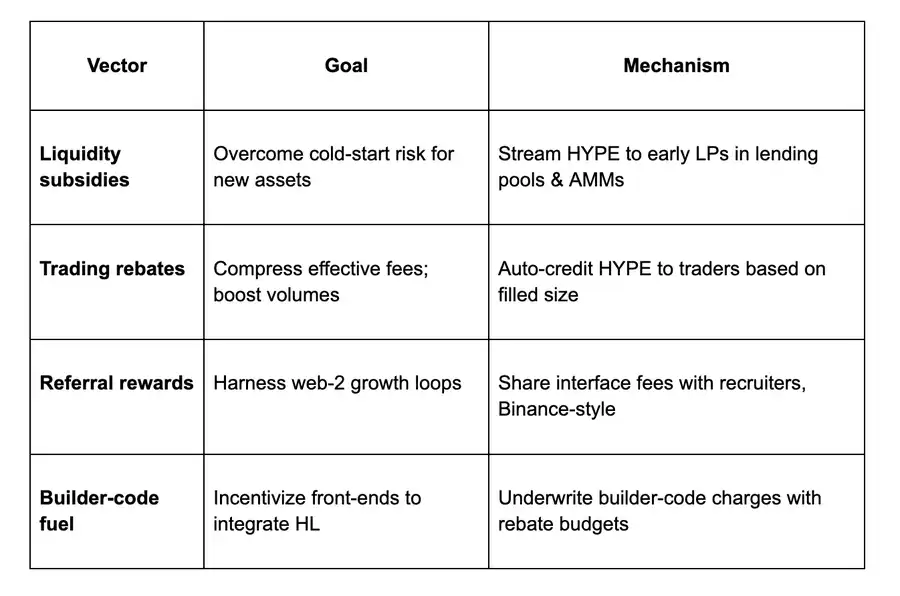How does HUSD break the monopoly of stablecoins and feed back to the Hyper ecosystem?
Original title: What does it mean to be a Hyperliquid-aligned fiat stable?
Original author@husd_fiat
Original compilation: zhouzhou, BlockBeats
Editor's note:HUSD is a public stablecoin project launched by Hyperliquid, which will return stablecoin interest to the ecosystem for repurchasing HYPE, subsidizing interface fees, and supporting the Builder Code model to promote ecological growth. It breaks the USDC/Tether model and allows funds to no longer flow to centralized institutions, but to feed back the community and product development.
The following is the original content (the original content has been edited for ease of reading):
What the
HUSD's story is about how to disrupt a multi-billion dollar stablecoin market. Hyperliquid initially emerged as a leading perpetual contract decentralized exchange (perp DEX), outperforming older players like DYDX and GMX. As the product continued to attract new users and was gradually introduced to the spot market, Hyperliquid evolved into a Binance/Coinbase competitor. Next, the ecosystem will be challenged by the fiat stablecoin duopolys of Circle and Tether.
Currently, approximately $2.5 billion in cross-chain USDC is locked in HyperCore's order book and earns about 4.3% in interest earnings. These earnings could generate approximately $107.5 million annually for Circle Internet Financial into its private balance sheet. With each new USDC deposit into Hyperliquid, Circle's cash flow is further expanded. But what if that value doesn't go to Circle, but instead goes to grow the Hyperliquid ecosystem? Why should we be tied down by the outdated traditional stablecoin model of USDC when there is an opportunity to break out of the existing framework?
choosing to inherit the old stablecoin

As Hyperliquid's influence in on-chain trading continues to expand, so does the net deposits of fiat stablecoins, providing liquidity to the perpetual contract market and spot market. In a future where Hyperliquid grows 10x, 100x, or even 1000x, the opportunity cost of continuing to use traditional stablecoins will get higher and higher. This value from the stablecoin layer will either continue to flow to Circle and Tether's balance sheets, or flow back into Hyperliquid's own ecosystem.
a new stablecoin model
, has proven through the automatic repurchase of HYPE that the cash flow generated by the protocol can and should be directly fed back to the community. In the past 30 days alone, the aid fund has recovered millions of dollars in HYPE from the market.
HUSD continues this strategy, but at the stablecoin level: initially, a large portion of the interest income generated by HUSD will be used to purchase HYPE, which will then be deployed in various growth directions of the Hyperliquid ecosystem. In other words, every time you use HUSD, you add buying pressure to HYPE and reinvest value into Hyperliquid's growth.
How will the repurchased HYPE be used?

HUSD: Fueling
HUSD has played a key role in driving the explosion of the "Builder Code" business model. The Builder Code is a native feature of Hyperliquid that allows an interface operator to charge a fee for spot or futures trades submitted on behalf of a user. Its goal is to monetize Hyperliquid's "last-mile distribution" — meaning that anyone who can effectively attract and retain users can use Builder Code to build a trading business that is not limited by technology or liquidity.
The unit economics of this type of business can be substantial, but at this early stage, new brands are still facing a "cold start" and the moat between the different interfaces is not yet obvious. The advent of HUSDs can help these "Hyperliquid hybrids" kick off and provide a way to differentiate themselves from each other.
By subsidizing the cost of the Builder Code by HUSD, the interface can charge the user more than it would otherwise be, without increasing the cost to the user. The interface captures revenue in real-time and further leverages those funds for growth strategies.
Let's take this as an example: Let's say Interface XYZ gets a rebate budget of 100 HUSD. All futures transactions with their Builder Code will be counted by the system, and the rebate balance of the corresponding user will continue to grow. The interface can handle at least about $100,000 in contract volume (i.e., 100 HUSD divided by 0.1% fee rate) before users actually start incurring fees. At the same time, interface operators can reinvest the revenue generated by Builder Code into user acquisition or user retention.
This is how HUSD is powering the "real-time growth" of the Hyperliquid ecosystem.
SummaryHUSD
integrates two core insights: the denominated asset (stablecoin) used for trading and the cash flow generated by it, which are integrated into the trading platform system. The end result is a stablecoin of the nature of a "public good", which transforms the originally static reserve interest into the active and compounding growth of the Hyperliquid ecosystem.
HUSD is a public goods project run by Felix and supported by community members, and it will go live through the Felix Points system. This deployment also builds on the foundation laid by @m0foundation, and it is its vision of a "global stablecoin platform" that makes HUSD possible.
Hyperliquid has upended the centralized exchange landscape, and HUSD is poised to do the same with traditional fiat stablecoins.
"Original link".
